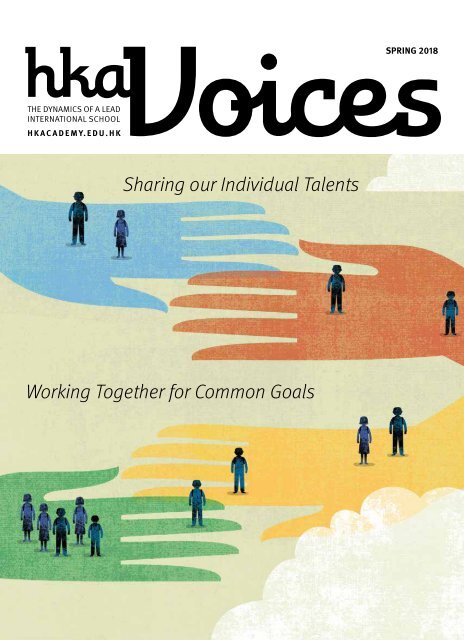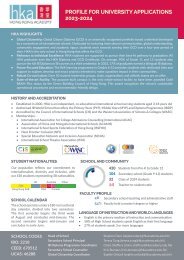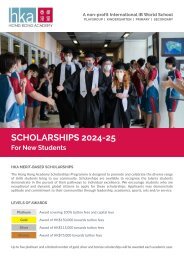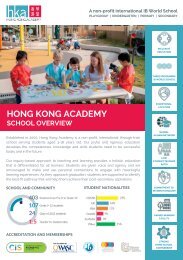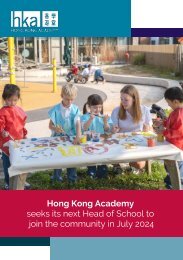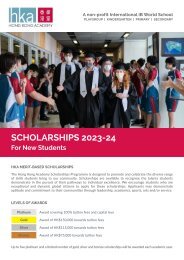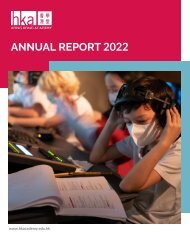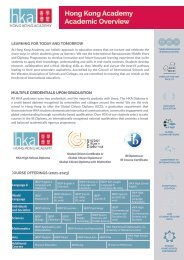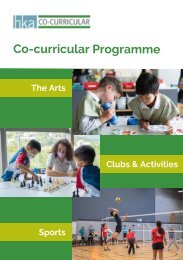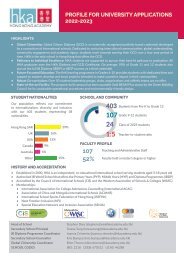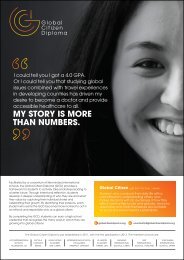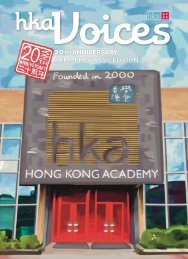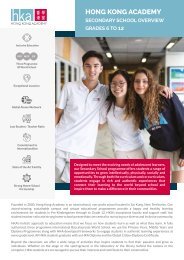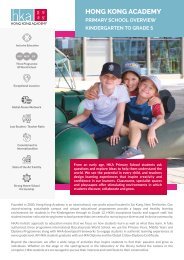hkaVOICES - Spring 2018
A bi-annual magazine for the Hong Kong Academy community.
A bi-annual magazine for the Hong Kong Academy community.
You also want an ePaper? Increase the reach of your titles
YUMPU automatically turns print PDFs into web optimized ePapers that Google loves.
hkaVoices<br />
<strong>Spring</strong> <strong>2018</strong><br />
The dynamics of a lead<br />
international school<br />
hkacademy.edu.hk<br />
Sharing our Individual Talents<br />
Working Together for Common Goals
hka<br />
Voices<br />
letter from the editor<br />
Dear Hong Kong Academy Community,<br />
In a crowded city like Hong Kong, we spend so much time with other people that it’s hard to imagine what it would be like to be entirely<br />
alone. Movies like Tom Hanks’ Cast Away and Daniel Defoe’s classic novel Robinson Crusoe provide fictional accounts of life on deserted<br />
islands (although Crusoe does encounter some locals), but the experiences of the leading characters seem far from our everyday,<br />
non-fiction lives. And rightly so. We are all members of multiple communities, embedded in systems, and often working together to<br />
further goals we hold dear.<br />
A major theme running through this issue of hkaVoices is the importance of team. Collectively, the articles evoke the words of Helen<br />
Keller, “Alone we can do little; together we can do so much.” Whether it’s students raising funds for refugee relief, teachers taking a<br />
multidisciplinary approach to their craft, parents helping out at school or the hkaEATS staff preparing food each day, life at HKA<br />
depends on teamwork. As a group committed to the school’s mission, vision and values, we all do our part to support our students<br />
on their pathways to individual excellence.<br />
Warmly,<br />
Laura Mitchell<br />
Director of Institutional Advancement<br />
The first arts trimester concluded with Grade 6 visual artists completing their Fantasy Fruits. Inspired by British ceramicist Kate Malone,<br />
Grade 6s observed real fruits and vegetables and then combined them in unusual, imaginative ways to create their fantasy designs. The<br />
sculptures are hollow, formed from clay, with textured additions adding detail, and then glazed to give them a bright, juicy appearance.
contents<br />
n Accreditation: A Literary Interpretation 2<br />
n Inclusive on Every Level 4<br />
n Supporting Student Well-Being and 5<br />
Safe Learning Environments<br />
n Getting the Concept Right: The Importance of 6<br />
Conceptual Understanding in Mathematics Education<br />
n Standing with Refugees 10<br />
n Got a Minute? Opening with Impact 12<br />
n ISTA at HKA 14<br />
n Ready to Learn! 15<br />
n A Day in the Life of a Chef 16<br />
n Grateful & Playful 18<br />
n Alumni Connections : London 19<br />
n Alumni Perspectives | The Lau Family Back Home in Sydney 20<br />
n Behind the Scenes Hero | Mr. Jojit 21<br />
n Happenings 22<br />
n Contributors inside back cover<br />
33 Wai Man Road<br />
Sai Kung | New Territories | Hong Kong SAR<br />
tel +852 2655 1111 | fax +852 2655 1222<br />
hkacademy.edu.hk<br />
Editor Laura Mitchell<br />
hkaVoices is published twice a year by the Institutional<br />
Graphic Designer Amie Shaw Advancement office of Hong Kong Academy. It is distributed<br />
Photography Mirko Jeck free of charge to current, former and potential future members<br />
Photography Jennie Tsang of the HKA community. Please contact Laura Mitchell with your<br />
story ideas or comments at laura.mitchell@hkacademy.edu.hk.<br />
Paper: Mango Satin, a recycled paper with fiber of well managed forestry and Totally Chlorine Free (TCF).<br />
Ink: Soy inks were used for printing. Printer: Pixel Printing, Hong Kong an FSC certified printer.
Accreditation:<br />
A Literary Interpretation<br />
by JENnifer Swinehart<br />
As an English literature teacher of nearly 20 years, I have<br />
frequently witnessed the transformative power of literature in the<br />
classroom. Through their encounters with fictional boys and girls,<br />
humans and animals, and heroes and villains, students time and<br />
again have finished reading a play, novel, short story or poem<br />
and expressed a newfound understanding both of the world and<br />
of themselves. Often, the characters we love in literature have the<br />
capacity to encourage us to contemplate ideas and issues in a<br />
way that the real world might not; through fiction, we as readers<br />
see what might otherwise be invisible to the eye.<br />
Hong Kong Academy is currently in the process of being reaccredited<br />
by three organisations: the Council of International<br />
Schools (CIS), the Western Association of Schools and Colleges<br />
(WASC) and the International Baccalaureate Organisation (IBO).<br />
The purpose of accreditation is twofold: to evaluate all aspects of<br />
a school’s programme against internationally-agreed standards;<br />
and to reaffirm our identity as a school as we embark upon the<br />
next stage of our organisation’s development.<br />
The dispositions and skills required in a meaningful accreditation<br />
self-study are the same ones we teach our students; these are<br />
also the same attributes we often find in literary characters. To<br />
this end, I thought it befitting to examine how we engage in the<br />
accreditation self-study process by making connections to some<br />
of my favourite pieces of literature.<br />
The Hound of the Baskervilles, Sir Arthur Conan Doyle (1902)<br />
In the characters of Sherlock Holmes and Dr. Watson, Doyle<br />
crafted two literary sleuths who embody the self-directedness<br />
and introspection essential to an effective accreditation process.<br />
In their many cases, detectives Holmes and Watson look at<br />
evidence from a variety of perspectives and place value on<br />
different data points in order to make meaning within a given<br />
situation. Together, they are dogged in their determination to<br />
solve the mystery in front of them; they are committed to seeing<br />
the process through and seeking resolution. As well, each knows<br />
himself as a thinker and leverages his strengths, particularly<br />
when it comes to complementing the other’s approach. These<br />
methods of detective work mirror the process we undertake<br />
through accreditation; self-study teams collaborate to seek<br />
understanding of the accreditation domain standards, supporting<br />
one another to interpret and apply information in search of a<br />
clear outcome.<br />
The Wonderful Wizard of Oz, L Frank Baum (1900)<br />
Dorothy knows she isn’t in Kansas anymore and that the only<br />
way for her to get home is with help. Throughout her journey<br />
down the Yellow Brick Road, Dorothy seeks input from the<br />
residents of Oz to find out what they think she should do next.<br />
The Scarecrow, Tin Man and Cowardly Lion all join Dorothy in her<br />
quest, sharing in the goal of persuading the Wizard to help them<br />
become more insightful, caring and courageous respectively.<br />
The quartet demonstrates the power of multiple perspectives<br />
and the importance of creating opportunities for shared voice<br />
and how important balance is within the individual. Each of<br />
the accreditation domains asks us to consider unique yet<br />
interconnected aspects of our school and reminds us that each of<br />
these areas is essential as we continue to grow.<br />
The Hobbit, JRR Tolkien (1937)<br />
The hero’s journey is a quintessential feature of literature that<br />
transcends time and space; from Odysseus in the ancient Greek<br />
poem The Odyssey to Atticus, Jem and Scout Finch in Harper<br />
Lee’s To Kill a Mockingbird, literary heroes have faced trials and<br />
tribulations in their journeys of self-discovery that have ultimately<br />
made them better people. In The Hobbit, Bilbo Baggins discovers<br />
previously unknown bravery and fortitude as he leaves the<br />
comfort of his home and embarks on a journey for treasure. Along<br />
the way, Bilbo experiences success and realises his own capacity<br />
for growth; moving forward, he is determined to build on these<br />
newfound skills to be triumphant. In the context of accreditation,<br />
we might see our treasure as the four drivers of the CIS process:<br />
purpose and direction, student learning, student well-being and<br />
the development of global citizenship. Through these lenses,<br />
we reflect on our achievements to date, identify the factors that<br />
have made us successful and set goals for our next stages of<br />
development so that in future we can be even more effective in<br />
putting our mission into practice.<br />
Charlotte’s Web, EB White (1952)<br />
The spider Charlotte in Charlotte’s Web is a character whose<br />
beliefs are evident in her behaviour. Destined for an early death,<br />
Charlotte’s barnyard companion Wilbur hopes to defy his destiny<br />
as a pig and enjoy a long life. In support of Wilbur’s goal of<br />
survival, Charlotte demonstrates her resolve and moral purpose<br />
by doing all that she can to help him in this endeavour, spinning<br />
web after web with messages meant to keep his dream alive.<br />
During the accreditation process, schools must reflect on their<br />
2
own policies and practices and evaluate the extent to which<br />
they are in alignment with the school’s mission. Our goal is to<br />
behave as Charlotte does — like her, our convictions should be<br />
lived, exemplifying the importance of aligning our day-to-day<br />
procedures with our overarching mission.<br />
The Little Prince, Antoine de Saint-Exupéry (1943), translation<br />
Richard Howard (2000)<br />
The Little Prince, the title character in the novella The Little Prince,<br />
offers observations about life based on his encounters with<br />
people during his exploration of several planets. The Prince’s<br />
impressions of human nature are often sombre, however during<br />
his travels on Earth he meets a fox who reveals to the Prince the<br />
power and value of relationships. “It’s the time you spent on your<br />
rose that makes your rose so important” (Howard, 2000: 64),<br />
explains the fox, reiterating that the value one places on an idea,<br />
person or object should be reflected in one’s actions.<br />
At HKA, we have strong beliefs about education; our collective<br />
identity is driven by our mission as well as our passion as<br />
educators, parents and learners. The self-study component of<br />
the accreditation process reaffirms these values throughout our<br />
community and empowers us to ensure the sustainability of our<br />
mission and guiding statements in the years to come. Like the<br />
Little Prince, we know we are responsible for our rose and for<br />
nurturing it within and beyond our time at HKA.<br />
Through accreditation, we have the opportunity to engage<br />
in a process that is self-directed and introspective; seek out<br />
perspectives from all community stakeholder groups; reflect<br />
on our successes and set priorities for our next stages of<br />
development; ensure school policies and practices are aligned<br />
with our mission; and nurture the sustainability of HKA’s<br />
identity, beliefs and values. By connecting these opportunities<br />
to literature, we should feel inspired by the potential inherent<br />
in accreditation for us to refine and extend our convictions<br />
as a school and deepen our understanding of ourselves as a<br />
community.<br />
3
Inclusive on<br />
Every Level<br />
by Nicole Aschenbrenner, Sarah Konopka and Maggie Taggart<br />
Central to the HKA mission and programme is the belief that all children deserve the opportunity to fulfill their greatest potential and<br />
that all children can learn in a shared environment to their mutual benefit. As a part of that inclusive perspective, the school takes<br />
a multidisciplinary approach to teaching and learning. Drawing on their specialised knowledge and skills sets, our faculty teams<br />
collaborate across disciplines to enhance student learning. The sum is more than the parts, and this extends beyond the walls of the<br />
classroom or a particular grade level. The result is an intentional, inclusive environment that ensures that children are learning together<br />
in a community that reflects the world at large. This intentional inclusion and diversity is supported by teachers with training in special<br />
needs education as well as language acquisition support.<br />
Who Makes up the Team?<br />
Typically, a multidisciplinary team, such as a Child Study Team, draws on individuals working in several specialities or disciplines<br />
to explore challenges and solutions. A multidisciplinary team will likely include teachers, co-teachers, specialists, learning support<br />
teachers, an Education Specialist, a Board Certified Behaviour Analyst (BCBA), an Occupational Therapist and a Speech-Language<br />
Pathologist. In addition, at HKA, any member of the staff and community may also be called on to take part in a multidisciplinary team.<br />
For example, parents may be asked to share their expertise during a class’s Unit of Inquiry.<br />
What are the Benefits of a Multidisciplinary Approach?<br />
The benefits of a multidisciplinary approach are plentiful. Each member of the team brings a diverse professional background and skill<br />
set as the team works together to achieve the same goals and support a student’s learning. Different perspectives enhance existing<br />
approaches and encourage new ideas that are adapted to the situation. Because of the clear benefits, multidisciplinary collaboration<br />
has become integral in education design and practice.<br />
What does a Multidisciplinary Approach Look Like?<br />
If you walk the halls at HKA, you’ll see this multidisciplinary approach in action. No matter the location, both classroom and learner<br />
support teachers are constantly working together to develop differentiated activities and strategies that take into account language,<br />
motor and sensory perspectives. Classroom set up and design also support our multidisciplinary approach. When you walk into an HKA<br />
classroom, take a moment to observe the intentional and varied seating options, visual schedules, and fidget tools in place for the<br />
students.<br />
Mutual Benefit: the Value of a Multidisciplinary Approach and Inclusion at HKA<br />
At HKA, we believe in the mutual benefit of an inclusive educational environment, and central to effective inclusion is a multidisciplinary<br />
perspective. The benefits of this approach transfer to staff, students, and the community as a whole. Inclusive learning strategies may<br />
be designed for one student and taught in a one-to-one setting, but they can often be generalised in class as students learn with their<br />
peers. Through collaborative planning, staff learn from each other as they manage a classroom of individualised and self-directed<br />
learners. This ongoing sharing of expertise nurtures creativity and confidence as faculty support students and each other.<br />
4
supporting<br />
student well-being and safe learning environments<br />
by Kristel Solomon-Saleem<br />
Hong Kong Academy’s commitment to student well-being comes<br />
in many forms. We educate the whole child, taking into account<br />
such factors as developmental readiness, socio-emotional wellbeing<br />
and physical health. In this day and age, child well-being<br />
also includes child protection. We all see the headlines in the<br />
newspapers about incidents that can impact children’s safety,<br />
and we all seek to ensure our children’s welfare in this complex<br />
world in which we live.<br />
they know their students particularly well and can be especially<br />
responsive to students’ needs beyond classroom learning. The<br />
overall goal is to ensure that students possess the tools of self<br />
and social awareness to developing and sustain appropriate<br />
interpersonal relationships. When students possess these skills,<br />
they can move forward confidently as self-directed learners who<br />
make responsible decisions.<br />
When thinking about child safety, we recognise that we need to<br />
take into consideration a number of factors. Research shows us<br />
that being an effective self-advocate is an essential component<br />
to children’s safety. Therefore, as we look at our commitment to<br />
child well-being, we work proactively to teach students ways to<br />
stay safe and effectively advocate for themselves. At the same<br />
time, we as adults do our part to create a safe and captivating<br />
learning environment.<br />
To be effective self-advocates, students must be both selfaware<br />
and equipped with the skills to express themselves<br />
and seek appropriate help. To that end, in our Primary School,<br />
our counsellor and teachers draw on Conflict Management<br />
programmes to teach children how to assess problems and ask<br />
a trusted adult for help when necessary. They also learn to apply<br />
their own strategies to fix problems. Being able to problem-solve<br />
on their own has the added benefit of building self-esteem and<br />
self-empowerment. Relatedly, students spend time with social<br />
skills programmes that support and develop their skills for<br />
building healthy relationships with those around them.<br />
Across all age groups at HKA, our commitment to empowering<br />
learners to pursue their individual pathways to success includes<br />
a celebration of differences and self-identity. In the Secondary<br />
School, self-awareness is a particular focus of the Advisory<br />
Programme. The Advisory Programme is also a key part of our<br />
helping students to feel comfortable with approaching an adult<br />
for assistance. As Advisory teachers meet with students every day,<br />
The digital age further adds to the need for this self-awareness<br />
and understanding of digital wellness. Within the school<br />
environment, our goal is to work together with students and<br />
families to identify ways in which we can utilise technology in a<br />
safe and beneficial way. To shape this conversation, we draw<br />
on leading resources, such as Common Sense Media,<br />
www.commonsensemedia.org, which teaches students about<br />
their online presence and helps students and parents alike<br />
navigate the seas of the cyber world.<br />
In addition to proactively equipping our students with the most<br />
effective tools for making decisions, it is also our responsibility<br />
to create a safe and captivating learning environment. HKA has<br />
developed a number of processes and protocols to support all of<br />
our learners. Over the last two years, we created Child Protection<br />
Guidelines that outline expectations for working with all children.<br />
We continue to train and provide professional development for<br />
all faculty and staff who are affiliated with HKA. Most recently we<br />
engaged an external consultant from the JANE Group to review<br />
our protocols and documentation to ensure we are putting all the<br />
appropriate structures in place to keep our children safe.<br />
As we move forward on this journey as a school, we recognise<br />
that our work will always be ongoing to ensure that we are<br />
responding appropriately and effectively to our changing world.<br />
We look forward to not only working with our HKA families but our<br />
community at large, so that we might set a standard for protecting<br />
and empowering all of our learners.<br />
5
Getting the<br />
Concept Right:<br />
The Importance of Conceptual Understanding<br />
in Mathematics Education<br />
by Shane McKinney and Maria Tullberg<br />
What do we mean by<br />
conceptual understanding and<br />
why is it important?<br />
When asked what they think about<br />
mathematics, some students might say,<br />
“It’s complicated. There are all these rules<br />
and facts to remember.” Many of us might<br />
remember the drilling of multiplication<br />
tables; we might even have a stereotypical<br />
image of children chanting in unison,<br />
“One times two is two. Two times two is<br />
four …” More recent rote methods include<br />
rhymes, songs, visuals and movements<br />
in an attempt to learn the ‘tricky’<br />
multiplication facts.<br />
Now fast forward to <strong>2018</strong> and peek<br />
into the classrooms of Hong Kong<br />
Academy, where conceptual based<br />
learning and problem solving are<br />
part of the daily routine in Primary as<br />
well as Secondary School. So, what is<br />
conceptual understanding? Simply put, it<br />
is understanding mathematics in context<br />
and knowing more than isolated facts and<br />
arithmetic. Successful mathematicians<br />
do not only rely on memory to solve a<br />
multiplication fact, but also use number<br />
sense — they know how to be flexible with<br />
numbers. A successful mathematician<br />
is actively building new knowledge from<br />
“Working with manipulatives makes you better at maths because<br />
you can solve problems mentally and try different ways. The<br />
balance tiles are challenging because it really makes me think.”<br />
Brenton, Grade 3 mathematician, on using Marcy Cook tiles to<br />
solve algebra puzzles.<br />
6
experience and prior knowledge and has<br />
the ability to transfer this knowledge<br />
into new situations. For students at HKA,<br />
this means learning mathematics by<br />
developing an understanding of how to<br />
approach a problem. They inquire into<br />
what skills they need to solve the problem<br />
and apply their knowledge accordingly.<br />
Interestingly, and perhaps surprisingly<br />
to many of us, this method of teaching<br />
mathematics is similar from Kindergarten<br />
all the way through Grade 8 and beyond.<br />
What does building conceptual<br />
understanding look like at<br />
different grade levels?<br />
In Kindergarten, children explore<br />
mathematics concepts by considering<br />
concrete situations they might themselves<br />
encounter. For instance, students might<br />
pretend to jump on a bus, sitting down<br />
on chairs lined up in five rows of two. The<br />
students observe that the bus can only<br />
take ten people, leaving some of their<br />
classmates without a seat. “What can we<br />
do?” the teacher asks, looking somewhat<br />
worried. “Let’s get on another bus!!” the<br />
children concur excitedly. This experience<br />
prepares the students for next steps, such<br />
as building ten frames. These frames are<br />
a key component to understanding our<br />
number system, and students with a solid<br />
grounding in this concept are prepared<br />
to develop the skills of addition and<br />
multiplication.<br />
Throughout the early Primary Years<br />
Programme, students continue to learn<br />
about ‘rows’ and ‘groups of’. In Grade 3,<br />
this groundwork turns first into an array<br />
and then later the area model. The area<br />
model is a cornerstone, and for some<br />
even considered a little bit of magic, to<br />
help us understand multiplication by<br />
using our knowledge in geometry. When<br />
learning a new concept, the children need<br />
to explore various manipulatives, such<br />
as base ten blocks or anything they can<br />
touch and move around, and build their<br />
own understandings at their own pace.<br />
The reward is that ‘aha’ moment when<br />
the student lights up and says, “Ahhhh!<br />
Now I get it!” Once that moment occurs,<br />
“It helps me to understand how subtraction works, especially when<br />
working with big numbers. It’s an easier way to look at it<br />
and understand it.”<br />
Rishi, Grade 3 mathematician, on subtracting using base<br />
ten blocks.<br />
it is difficult, perhaps even impossible,<br />
to unlearn that knowledge. The key is<br />
not to move on to the next step before<br />
they are ready; we teach the students to<br />
“build it, draw it, write it”, and this takes<br />
time. When the students are ready to<br />
understand and explain the concept, they<br />
will then find a more efficient algorithm<br />
such as ‘long division’. If that is not until<br />
the end of Grade 5, that’s ok. There is no<br />
need to rush.<br />
What using manipulatives<br />
and models looks like in<br />
Grades 6-8<br />
For effective learning, students must<br />
create their own meaning. In Grades 6-8,<br />
this implies using manipulatives and<br />
models as they develop their conceptual<br />
understanding. This is the same process<br />
as in the Primary School, and by Grade 6,<br />
most students have a large toolbox of<br />
procedures and strategies to employ. In<br />
Grades 6-8, the greater opportunity for<br />
learning centres around exploring new<br />
concepts that challenge students to use<br />
what they know and build upon it. What<br />
better way to build on their understanding<br />
than using manipulatives and models?<br />
“Working with base ten<br />
blocks helps me because<br />
I don’t have to use my<br />
fingers, especially when<br />
working with bigger<br />
numbers. When subtracting<br />
we just feed the ‘minus<br />
monster’ the number of<br />
blocks we’re taking away.”<br />
Lucy, Grade 3<br />
mathematician, on<br />
working on conceptual<br />
understanding of<br />
regrouping when<br />
subtracting.<br />
7
When students learn by doing in this way,<br />
they gain a deeper understanding of the<br />
concepts being explored and are then<br />
able to apply their understandings to a<br />
variety of situations.<br />
What comes after using<br />
manipulatives and models?<br />
After students have used manipulatives<br />
to solve enough problems, they are<br />
usually ready to start putting pencil to<br />
paper to model these problems and their<br />
solutions. As they model more and more<br />
of these problems, patterns begin to<br />
make themselves clear. Students often<br />
observe these patterns themselves, and<br />
conversations with a teacher add to that<br />
clarity. Once they are confident with their<br />
observations of the patterns, students<br />
use these patterns, usually with teacher<br />
guidance, to develop a more efficient,<br />
procedural method for solving the given<br />
type of problem.<br />
For example, one of the most significant<br />
concepts in Grade 6 maths is dividing with<br />
fractions. When doing a problem such as<br />
¾ ÷ ½, the first thing we want students to<br />
understand is what the problem is asking.<br />
The students have prior knowledge with<br />
division that can help them here. For<br />
“It’s easier to find the value of the ratio when you can see what it<br />
looks like.”<br />
Jeremy, Grade 6 mathematician, on using models to solve ratio<br />
problems.<br />
instance, in earlier grades they may have<br />
learned that 9 ÷ 3 is a way of asking “How<br />
many 3s are in 9?” They should be able to<br />
transfer this knowledge to division with<br />
fractions. ¾ ÷ ½ by asking “How many<br />
½ pieces are in ¾ of a piece?” Once they<br />
understand this, they are ready for using<br />
manipulatives and creating bar-models.<br />
After constructing a sufficient number<br />
of models, students will start to see a<br />
pattern for a more efficient procedure<br />
for division than what most of us<br />
learned when we were in school. In our<br />
collaborative learning environment,<br />
students often see the pattern because<br />
they are helping each other to make<br />
observations and identify patterns.<br />
Regardless of how students first see<br />
the pattern, the understanding gained<br />
enables them to adopt the more efficient<br />
procedure for solving the problem. By the<br />
end of the unit with Grade 6 students,<br />
they understand not only to flip over the<br />
second fraction and multiply (multiply by<br />
the reciprocal of the divisor), they also<br />
understand the concept well enough to<br />
explain why this will work.<br />
“People visualise differently and models or manipulatives can help<br />
people to understand a problem in a different way.”<br />
Jorja, Grade 8 mathematician, on using algebra tiles to solve<br />
algebraic equations.<br />
Whether in Primary School or in the<br />
early years of Secondary School, much<br />
of the process of learning maths is the<br />
same. When a new concept is being<br />
explored, students are encouraged to use<br />
manipulatives that they can see, touch<br />
and move around. After they become<br />
more familiar with this new concept,<br />
they can create models to show their<br />
understanding. Finally, students use<br />
what they learned through their use of<br />
8
“Using manipulatives can help<br />
you because they’re more visual<br />
which is good because you can<br />
touch and move around the<br />
tiles.”<br />
Zahra pictured with<br />
Frankie, Grade 7<br />
mathematicians, on using<br />
integer tiles to add and subtract<br />
positive and negative numbers.<br />
manipulatives and models to develop<br />
a more efficient procedural method for<br />
solving the given type of problem, usually<br />
with some teacher guidance. Over time,<br />
students draw on their growing tool box<br />
to tackle more challenging concepts. The<br />
exciting ‘aha’ moments happen all along<br />
the way!<br />
What can parents do at home to support<br />
conceptual understanding?<br />
For many parents, helping children with maths homework can be challenging.<br />
The following are some simple things parents can do at home to support their<br />
children’s conceptual understanding. Most of these involve asking your child<br />
some simple questions about what they are doing.<br />
When a learner has trouble getting started on a problem,<br />
trying asking:<br />
What do you know about this problem?<br />
Have you seen a problem like this before?<br />
What do you picture in your head for this problem?<br />
How could you organise what you know to help you figure out<br />
what this problem is asking?<br />
When we focus on conceptual<br />
understanding in the area of mathematics,<br />
we can see the importance of students<br />
building their own meanings when<br />
exploring new concepts. Procedural<br />
methods may be quicker and more<br />
efficient, but without a foundation of<br />
conceptual understanding, the students<br />
will not be able to transfer these skills<br />
to new and various types of problems.<br />
Procedural and factual knowledge<br />
are very important in the realm of<br />
mathematics, but just as important is a<br />
strong conceptual understanding. This<br />
conceptual foundation allows students to<br />
transfer their procedural knowledge to a<br />
variety of new and unfamiliar situations<br />
and to apply mathematics to real-world<br />
situations.<br />
When a learner has worked out a solution, consider<br />
following up with these questions:<br />
Can you show how your solution makes sense?<br />
Can you explain what you did to solve this problem?<br />
Why did you solve the problem this way?<br />
Can you do it in a different way to check that it still works?<br />
9
Standing with<br />
Refugees<br />
Giving time, energy and resources to make a<br />
difference for others — a charity walk<br />
BY Chloe Dare<br />
The Arab <strong>Spring</strong> in 2011 is popularly known as the starting point of what we now know as<br />
the Syrian Civil War, an ongoing conflict characterised by brutal protests and violence.<br />
This wave of uproar in the Arab world has come to have the greatest effect on Syria as a<br />
result of the conflict started between the Syrian people and the Assad Regime. As this<br />
conflict has progressed, Syria has become increasingly divided as the government, rebel<br />
groups, and religious extremist organisations have formed, causing the country to be in a<br />
state of terror. However, in the midst of this conflict, where do the Syrian civilians stand?<br />
Syria has become the number one source of refugees in the world, making this conflict<br />
an international matter. Simply because we aren’t living in the midst of conflict doesn’t<br />
mean that its repercussions are not experienced world-wide. This ongoing conflict has<br />
displaced a third of the Syrian population<br />
within the country, and an astonishing 4.9<br />
million have evacuated to other parts of<br />
the world. Many of these Syrians make an<br />
arduous journey to camps in neighbouring<br />
countries or even further to some parts<br />
of Europe. European governments have<br />
varied in their response to this issue and<br />
still accept far fewer than any of Syria’s<br />
neighbouring countries. Europe has a<br />
more stable economy, social system, and<br />
industry in comparison to countries taking<br />
in most refugees and could arguably<br />
better handle this influx of people if they<br />
desired to do so. This can be equally said<br />
for the rest of the Western World as well.<br />
While governments and international<br />
leaders are dealing with the problem in<br />
People from all over Hong Kong walked in support of Syrian Refugees.<br />
one manner, non-profit organisations<br />
and private individuals around the world<br />
are also actively engaged in aiding Syrian Refugees. One organisation at the fore of<br />
refugee relief is World Vision. World Vision aims to supply Syrian refugees with food and<br />
education, mainly targeting children who make up around half of all Syrians fleeing the<br />
country. Every year a walk is held by World Vision to collect donations to support these<br />
camps to give these children a better quality of life.<br />
10
HKA students joined the walk in support of Syrian refugees.<br />
Around the world, communities come together in partnership with World Vision in a walk<br />
to highlight the plight of refugees and to raise funds to aid the relief efforts. On 21st<br />
October 2017, a group of students, including myself, involved Hong Kong Academy in this<br />
walk and raised 11,230 HKD for the movement. Everyone was willing to make a generous<br />
contribution to the cause, showing that collectively we can make a difference. Though it<br />
may not be a long term solution, any relief for these children is worth the donation. The<br />
walk in itself was also a valuable lesson for those who participated.<br />
Though it is impossible to understand what the journey of a refugee is like, the walk was<br />
a symbol of people coming another step closer to being aware of the issue. Refugees are<br />
just like us and they have been forced to make this journey to suddenly evacuate their<br />
homes. It is a common misconception that everyone fleeing is poor, but dislocation due<br />
to armed conflict can impact everyone, and often has a greater impact on those with<br />
fewer resources to begin with. It is difficult to imagine being kicked out of your house<br />
onto the streets, only to be labelled as a faraway problem that people occasionally feel<br />
sorry for. I have been guilty for acting in this same manner, which is why my group and I<br />
are promoting awareness on the issue.<br />
Orange ribbons, sometimes made from<br />
life jackets, have come to represent the<br />
refugee crisis.<br />
When we set out for this walk, we got to pack our water, prepare, stare at the beautiful<br />
view of a golf course and at the end of the day, take a taxi if we were feeling tired. All<br />
these luxuries are ones we take for granted, and understanding this privilege is important<br />
in being able to even begin to be aware of the problem at all. It is unrealistic to expect<br />
that everyone should go to Syria to prove they care, but people can still play a small<br />
part where they are now. Though it is not a lasting solution, it is important to realise the<br />
critical role all of us play, not only financially, but also in terms of awareness because<br />
once we start ignoring the problem, that is when we truly disrespect those who are<br />
fighting for a better future.<br />
11
Got a minute?<br />
opening<br />
with<br />
impact<br />
by Kendall Zoller<br />
Educational writer and consultant Kendall Zoller visited HKA<br />
in October 2017 to present a workshop on developing effective<br />
presentation and communication skills. Over two days, Zoller<br />
offered a number of nonverbal skills and strategies that can aid<br />
in establishing credibility, building rapport and understanding<br />
groups in both formal and informal settings. In the article below,<br />
he shares six skills for effectively communicating in the first<br />
minute of speaking. These skills can contribute to the creation<br />
of a dynamic learning community in the classroom and beyond.<br />
Zoller’s visit to HKA is just one example of the sort of professional<br />
development that takes place on campus throughout the year and<br />
that contributes to HKA’s identity as an educational leader.<br />
Hold a group spellbound in the first minute. Six skills, known<br />
by some, but not all, will catapult an opening into a first hour of<br />
intense intention.<br />
In the ten minutes it will take to read this article, you’ll finish<br />
with a powerful list of essentials for that first minute. For any<br />
group with which you meet, what you bring beyond words is more<br />
important than what you say.<br />
The six skills listed below have been tested in<br />
schools, government agencies, and corporations<br />
throughout the world. They are universal. Some<br />
can be accomplished in the same moment.<br />
1. Make an impact statement<br />
2. Establish credibility<br />
3. Breathe<br />
4. Pause and hold the gesture still<br />
5. Stand in stillness for 10 seconds<br />
6. Frame it<br />
The descriptions that follow will allow you to use each of<br />
these with immediate effect.<br />
Make an impact statement The first utterance out<br />
of the mouth of some presenters is “um” or “hello” or “Thank<br />
you.” These are neither good nor bad; they do, however, lack a<br />
“fire in the belly.” Great presentations begin with great opening<br />
statements. Some of the best are done in two sentences or less.<br />
The number of words is not important. What is important is that it<br />
lights a fire in the listener. Open the session with statements that<br />
intrigue, tap an emotion, give an insight, or shine a light in a dark<br />
recess of the audience’s minds. People may not always remember<br />
what you said. They will, however, always remember how they felt<br />
when you said it.<br />
Every session we deliver has an opening impact statement<br />
before we even bother to say our names. It is unique for each<br />
group, each day, and each topic. The impact statement gives the<br />
audience a reason to listen. In the corporate setting, we like to<br />
open with a statement that aligns with what people hold in their<br />
hearts about their work and goals. Our openings can be as simple<br />
and direct as “Imagine saving over 15% of current spending in<br />
less than six months without sacrificing your quality of people.”<br />
Or, “We have all heard the complaints of change and seen failed<br />
implementations. Today we are going to show you a pathway of<br />
success in two simple steps.”<br />
When working with school administrators, the opening taps into<br />
the passion and moral imperative of educating all children. An<br />
opening might be: “We all know the research about how high<br />
quality teaching impacts the quality of student lives. What is<br />
most surprising is that quality of life is not the only gain, so is<br />
longevity.”<br />
Establish credibility Many of us think it takes a long<br />
time to build credibility. The Choreography of Presenting says<br />
credibility is created through movements a speaker makes. Moves<br />
that convey to the audience they know what they’re talking about<br />
and are worth listening to. Nonverbally, credibility is achieved<br />
right away by standing still for about 10 seconds in that first<br />
12
minute, using a flatter-toned voice that drops in tone at the end<br />
of a phrase (like a newscaster or weather reporter). Between each<br />
sentence, you want to pause with a gesture in front of you that is<br />
still during that pause (try it). The body is straight and head is not<br />
tilted. However crazy that may sound, these patterns influence<br />
those in the audience to pay attention.<br />
you are worthy of being listened to. To give positive, nonverbal<br />
indicators to these questions, stand still. When we stand still<br />
the mind of the listener calms, takes in the data, and sees the<br />
speaker as non-threatening (that is important). You can move<br />
after the 10 seconds. The ten seconds is just so critical as a visual<br />
anchor for people to believe you are worth listening to.<br />
Breathe Simple as it sounds, breathe low. Breathe from<br />
the abdomen. Breathing influences all of our communication<br />
patterns. When speakers breathe high in the chest, they speak<br />
faster and louder — sometimes coming across as stern or too<br />
assertive. Breathing from the abdomen releases chemicals that<br />
calm the body and make speakers talk more slowly and clearly.<br />
Abdominal breathing contributes to a sense of certainty. Effective<br />
speakers also pause more often. Breathing also enhances the<br />
flow of oxygen into the brain. More oxygen helps you think more<br />
clearly, stay on point, and sustain flexibility.<br />
To pause and hold the gesture still like<br />
breathing may sound a bit crazy. Yet we all have the experience<br />
of listening to a nervous speaker. One who never paused, spoke<br />
too quickly, and finished early with virtually no one knowing what<br />
he or she said. When a speaker breathes quickly, the audience<br />
also breathes more quickly. Quick breathing impedes listening<br />
and even understanding. When we pause, we convey to others<br />
that more is coming. Holding a gesture still when we pause is<br />
also a visual indicator we have more to say. The gesture holds the<br />
attention of the group and contributes to the speaker’s credibility.<br />
Stand in Stillness for 10 seconds during the<br />
first minute. Stand still. Do this for about 10 seconds. Why? It’s<br />
about biology. When we are still people pay more attention to us<br />
in that moment. As animals we size up the person, are they friend<br />
of foe? Now, the people in the audience are not your foes, yet they<br />
are sizing you up. They are wondering if the presentation will be<br />
interesting. If you know what you are talking about. And lastly, if<br />
FRAME IT Frame what is important. Like fine art, the frame<br />
focuses and accents what is important in the painting. We want<br />
to ask ourselves as we prep — what do we want those in the<br />
audience to think, feel, do and say as a result of our session?<br />
Thinking and feeling are paramount because when thinking<br />
is linked to feelings (emotions) people remember. Doing and<br />
saying are also important, since what we do and say is what we<br />
remember. So, this frame is all about remembering the moment.<br />
Since we can’t always tell them what we want them to think,<br />
feel, do and say, we have to talk and act in ways that do it. It all<br />
starts with the opening. For instance, if you want your audience<br />
to think they contribute to a moral imperative about dignity and<br />
life (as noted above), your intent is to leave them feeling morally<br />
satisfied. This encourages them to do work that supports dignity<br />
and respect. It also acknowledges how they stay true to what is in<br />
their hearts when teaching children.<br />
So, there you have it, six gifts you can immediately use in your<br />
next session. Six gifts that may take you to the next level of<br />
client satisfaction and professional respect. Are there more<br />
things to do in the first minute? Sure, and do them. We feel that<br />
if you do at least these six, you gain three things. First, a greater<br />
satisfaction from the audience. Second, a strengthening of<br />
the professional relationship. And third, recognition for being<br />
a great communicator. Anne Morrow Lindbergh said, “Good<br />
communication is just as stimulating as black coffee, and just as<br />
hard to sleep after.” Don’t let your participants sleep.<br />
If you would like to contact Dr. Kendall Zoller, he can be reached<br />
at kvzollerci@gmail.com.<br />
13
ISTA at HKA<br />
by Laura Mitchell<br />
Hong Kong Academy has a long tradition of theatrical arts. Long before we had a beautiful<br />
theatre, the school’s plays, workshops and drama classes were an integral part of the<br />
curriculum and the life of the community. In the Primary School, children looked forward<br />
to seeing, and eventually taking part in, the Grade 4 play. In the Secondary School,<br />
plays have featured prominently in the annual calendar and over time, productions have<br />
become increasingly student-led. Theatre at HKA has been important for parents, too, as<br />
a way to support our students and spend time together as a community.<br />
John Altman performing at HKA.<br />
Over the years, HKA has been an active member of the International Schools Theatre<br />
Association (ISTA). ISTA, a registered non-profit organisation in the UK with a global<br />
presence, offers a wide variety of theatre arts experiences around the world in ways<br />
that are highly aligned with HKA’s mission and which support the IB curriculum. ISTA<br />
believes that the future depends on confident, internationally-minded, collaborative<br />
and culturally literate young people who are empowered to engage with and change<br />
the world responsibly.<br />
HKA students have taken part in ISTA events here in Hong Kong, as nearby as Guangzhou<br />
and as far away as London. In 2017, HKA had the opportunity to become the local home<br />
for an ISTA Performing Arts Academy. HKA’s Director of Performing Arts, Anne Drouet,<br />
founder of the first ISTA Academy in Shanghai, serves as the coordinator for this<br />
programme as part of her responsibilities at HKA.<br />
HKA Secondary Students and sisters,<br />
Sonya Langley, Grade 8 and Eva Langley,<br />
Grade 11.<br />
The programme is already off to a great start with many exciting events, including several<br />
days with music legend John Altman. While on campus, John delivered masterclasses on<br />
Improvisation and Composition and Arrangement. He also performed live with students<br />
and faculty to the delight of an audience of parents, students and friends. During the<br />
evening concert, Anne interviewed John about his many decades in the music business,<br />
offering further insights into the world of the creative arts.<br />
Looking ahead, many more workshops are on the schedule, including a March weekend<br />
festival bringing together the two sister academies in Shanghai and Hong Kong to<br />
celebrate ISTA’s 40th birthday. Later this spring, HKA also anticipates a programme of<br />
workshops and masterclasses with the directing team of Evita and The Sound of Music<br />
world tour productions. For more information, visit www.ista-hongkong.com.<br />
John Altman on sax, Anne Drouet accompanying on piono, with Bianca De Leon, Grade 11,<br />
singing.<br />
14
READY TO LEARN! by<br />
Maggie Taggart<br />
How do we help students to be calm, alert and ready for learning?<br />
Here is a look at how we support student self-regulation at HKA.<br />
Many of us have heard about the ‘marshmallow experiment’ from Stanford University in the early 1970s that cast light on the importance<br />
of self-regulation and control. Preschoolers were promised an additional marshmallow only if they could wait 15 minutes to eat the one<br />
they were initially given. The preschoolers who were able to wait 15 minutes for the additional marshmallow demonstrated a higher<br />
ability to cope with frustrations in adolescence, and also had better academic outcomes on standardised testing.<br />
3ren – Savasana<br />
“3ren is trying out something new this year. After lunch/recess, students<br />
come back to the room and lay in ‘Savasana’ (a fully conscious pose<br />
usually at the end of yoga practice). Cool, moist towels soaked in<br />
essential oils are gently placed on their foreheads. During this time,<br />
students enjoy calm relaxing music and are led through a guided<br />
visualisation or are asked to practise some sort of mindfulness (listening,<br />
breathing, digesting). Students have found this experience to be really<br />
helpful in calming, cooling, refocusing for the afternoon.”<br />
— Neha Pall, 3ren Teacher<br />
3ai – Mindfulness Coloring<br />
3ai begins some mornings doing mindfulness<br />
coloring and listening to calming music.<br />
Students have shared some insightful feedback,<br />
reporting that mindfulness colouring “helps you<br />
get relaxed and more ready for class and makes<br />
them feel “comfy”. One student said, “It’s very<br />
calm. Sometimes I like using a lot of colour and<br />
sometimes just a little.”<br />
Recent research has also shown that self-regulation builds<br />
the foundation for a child’s long-term physical, psychological,<br />
behavioural and educational well-being. In 2013, Stuart<br />
Shanker, a research professor and advisor on early childhood<br />
development, wrote about the tendency to confuse self-regulation<br />
with discipline or self-control. Self-regulation is about much more<br />
than mere discipline. Self-regulation is one’s ability to identify<br />
and modulate emotions and energy, control impulses and make<br />
thoughtful choices. Just as we tend to feel most comfortable when<br />
our thermostat is within a certain range, children also have a<br />
range or ‘zone’ in which they can best engage within their social<br />
and learning environments and cope with stressors.<br />
Students are continually developing their self-regulation<br />
throughout childhood. Supporting student self-regulation is<br />
an integral role of teachers as they create a physically and<br />
emotionally nurturing environment.<br />
References: Shanker, S. (2013). Calm, Alert and Happy. Shoda, Y.,<br />
Mischel, W., & Peake, P. K. (1990). Predicting adolescent cognitive and<br />
self-regulatory competencies from preschool delay of gratification:<br />
Identifying diagnostic conditions. Developmental Psychology, 26(6),<br />
978–986.<br />
15
A Day in the Life of a<br />
Chef<br />
by Chris Gallaga<br />
16<br />
Chris Gallaga, Chef of hkaEATS.<br />
We all eat, and many of us cook. It’s an experience many of us<br />
share and understand. But just as preparing for a dinner party<br />
for 20 is different than preparing a meal for a family, daily food<br />
preparation for a school community of nearly 1,000 is something<br />
different again! An operation like hkaEATS regularly serves<br />
nearly six-hundred or so meals before 2pm. This sheer volume<br />
dramatically impacts food preparation methods and approaches.<br />
The diversity of tastes and dietary needs at a school such as HKA<br />
is also much greater than at home. We feed an age range from<br />
3 to perhaps 70, taking into account different preferences and<br />
dietary needs. What is the same at home and school, however,<br />
is the planning that goes into healthy fare, and in a school<br />
environment, food’s nutritional value is treated with scientific<br />
scrutiny.<br />
Gary Wan, Chef de Cuisine of hkaEATS, preparing platters for an<br />
HKA event.<br />
For a school kitchen, the day starts early! Food preparation<br />
sometimes begins well in advance with marinating meats,<br />
chopping vegetables, making sauces, and coordinating the<br />
dozen or more team members who work together to make sure<br />
there’s food on the table at HKA. By 7am on any given day,<br />
loaves of breads and other baked goods are sliding in and<br />
out of giant ovens. Meanwhile, our seven or eight cooks begin<br />
preparing cafeteria meals. Each day we prepare about 30kg of<br />
raw produce (meat or vegetable) for any main dish. On Friday we<br />
prepare about 100 large pizza bases just for the cafeteria. The<br />
team also prepares starches (like rice and pasta), soups, salads,<br />
vegetables, sandwiches, and sundry items.<br />
Koon Lin Lee, Food and Beverage Assistant of hkaEATS, preps for<br />
lunch service.
By 8am on many days we are also preparing for one or more<br />
events for dozens of adults — perhaps parents, visitors, or<br />
teachers — that require the setup and delivery of coffee, tea,<br />
pastry, fruit, etc. By midday, the rush begins! Hundreds of<br />
students and adults gather and dine in the cafeteria for the<br />
daily hot meals, while dozens more crowd into the UG Cafe for<br />
lighter meals. On some days our catering operation goes into the<br />
evening for functions such as Back to School Night, curriculum<br />
evenings or other events.<br />
As the chef, I am often in the kitchen, but I also move about quite<br />
a bit throughout the day, ensuring service and production are<br />
meeting the needs at hand, interacting with our students, faculty<br />
and staff and helping anywhere that is experiencing a challenge.<br />
Once the lunch rush has quieted down, I assess that day’s<br />
successes and challenges and make notes for the next time the<br />
menu appears in the cycle.<br />
HKA Secondary Students enjoying one of their favourites, pizza.<br />
and preparation choices. All menu items are also considered for<br />
nutritional balance; drawing on scientific research and bearing<br />
in mind the timeless advice of the Oracle at Delphi: nothing too<br />
much. Ingredients are creatively substituted to reduce unhelpful<br />
fats or empty calories while increasing micronutrients, fiber,<br />
and developing overall macronutrient balance. Lean meats, and<br />
cleverly incorporated fruits, herbs, and vegetables are often<br />
employed to create that balance.<br />
Ann Lee, Food and Beverages Clerk of hkaEATS, all smiles with<br />
lunch in full swing.<br />
As you can imagine, menu preparation is a big part of the process<br />
for hkaEATS, especially as we take into account the seasonal<br />
availability of fruits and vegetables. We have two menus for every<br />
planning session. For the cafeteria, the menu is a four week long<br />
cycle that is repeated once or twice before a new menu and cycle<br />
begins. Over the course of a year’s four-cycle menus, we create<br />
48 main courses that include western, Asian and vegetarian/<br />
vegan options. In addition we plan four soups, side dishes and<br />
desserts, and a dynamic variety of salad bar items. Planning for<br />
the Upper Ground Cafe is equally intensive as we offer “grab and<br />
go” food, as well as dependable snacks, sandwiches, salads,<br />
hot items, and drinks. While the Cafe menu stays more the same<br />
than what’s offered in the cafeteria, we do adapt as items move in<br />
and out of popularity and as vendors introduce new ingredients<br />
worth a try.<br />
HKA student sampling the daily soup offering.<br />
To borrow an old saying, a chef must<br />
think like a scientist, organise like an<br />
accountant, inspire and motivate like<br />
a warrior, move like a track star, plate<br />
like an artist and cook like a grandma.<br />
A school chef is more or less the same.<br />
— Chris Gallaga<br />
Importantly, our menu and preparation processes are done within<br />
the school’s mission and values. In addition to basic issues<br />
of food safety, we actively take into account sustainability, fair<br />
labour, and environmental awareness in all our procurement<br />
17
Grateful &<br />
Playful<br />
by Laura Mitchell<br />
The 2017-18 school year opened with particular excitement in the Primary School with the inauguration of our<br />
new Playscapes. The Playscapes were long awaited, with the design and implementation taking place over<br />
several years. Parents celebrated the new play areas as well, both because of the smiles on the children’s faces<br />
and because the new features and equipment reflect the success of the school’s culture of philanthropy and<br />
growing annual fund programme. Thanks to everyone for making our Playscapes possible!<br />
HKA students definitely know what they like! Enjoy their candid responses when asked ...<br />
What do you like about your new Playscape?<br />
“When you bounce on the<br />
trampoline, I like the breeze!”<br />
“We pretend the sand is a beach<br />
and the water is a stream!”<br />
18
Alumni Connections:<br />
LONDON<br />
“We sometimes go into the garden<br />
and the mud kitchen to play!”<br />
More than 25 HKA alumni, former students and families, faculty<br />
and staff gathered in London. The weather was wet and cold,<br />
but the conversation was warm as everyone caught up over<br />
fabulous food and drink at The Ivy Chelsea Garden. The photos<br />
tell the story!<br />
The alums and former students in attendance ranged from age<br />
6 to the the Class of 2014. We have quite a few graduates at<br />
university in the UK, and we’re happy to report that they are<br />
all thriving. Our Head of School, Stephen Dare, said “It was a<br />
pleasure to all be together sharing memories of HKA and hearing<br />
the students’ stories about how well they are doing in their<br />
current schools and universities.”<br />
“EVERYTHING!”<br />
Keep us in the loop with LinkedIn<br />
HKA is a global community, and we enjoy staying in touch with<br />
alumni, former students and families around the globe.<br />
A great way to keep in touch is LinkedIn. If you haven’t already,<br />
please join our LinkedIn Alumni network for graduates and former<br />
students. It’s easy to participate. For students and alumni, just<br />
make sure you have ‘Hong Kong Academy’ mentioned in your<br />
LinkedIn profile under ‘Education’, and LinkedIn will do the rest.<br />
For HKA parents, follow our LinkedIn Company page.<br />
“The hammock goes really high!”<br />
Follow us everywhere.<br />
19
Alumni Perspectives<br />
The Lau Family<br />
Back Home in Sydney<br />
BY Barry and Julie Lau<br />
they needed some help, and the half year<br />
allowed them to settle into a good routine.<br />
The Lau Family, including parents Julie and Barry, twins Oliver and Jacinta, and Isabelle<br />
joined HKA in 2010. In 2016, the family returned to their hometown of Sydney, Australia.<br />
In this article, Julie and Barry share some of their thoughts about repatriation, getting the<br />
children settled into their new routines, starting at new schools and the value of family and<br />
friends when making a big transition.<br />
We also focused on keeping busy!<br />
Everyone missed their friends from<br />
HKA, but finding their groove in various<br />
activities helped ease the transition.<br />
Oliver has continued to play football<br />
(soccer) and has found rowing his<br />
thing this year. His artistic side is<br />
coming through with regular sessions<br />
with his school’s Art Club. Jacinta has<br />
played softball, netball, football, and<br />
touch rugby, so has been keeping<br />
busy throughout the year. Isabelle has<br />
continued with dance, is now playing the<br />
clarinet and has been a star on the netball<br />
court and touch rugby field. Through all<br />
these activities, all three of the children<br />
have cemented friendships, and they<br />
also have a strong bond with their Aussie<br />
cousins. The children now have the best of<br />
everything, with friends from around the<br />
world as well as in Sydney!<br />
It seemed like only yesterday that our<br />
twins, Oliver and Jacinta, and their<br />
younger sister, Isabelle, started their<br />
journey at Hong Kong Academy in Kennedy<br />
Town in 2010. Roll forward 6 years and we<br />
were saying goodbye to the beautiful HKA<br />
campus in Sai Kung and packing our bags<br />
to move back home to Sydney.<br />
Whilst the decision to move to Hong Kong<br />
was for work and career, our decision to<br />
move back to Sydney was primarily driven<br />
by our sense of where our kids should be<br />
educated during their senior school years.<br />
We decided to move back when Oliver<br />
and Jacinta (now 13) graduated from the<br />
PYP (Grade 5). Like all parents, we had<br />
trepidations as to how they would fit back<br />
into their new life in Sydney. We had all<br />
made firm friendships in Hong Kong and<br />
at Hong Kong Academy, and HKA was the<br />
20<br />
only school the children had ever known.<br />
Fortunately, we were able to go from<br />
farewells to a strong network of friends<br />
and family in Sydney.<br />
Fortunately the children proved very<br />
resilient and made good transitions, and<br />
a few choices we made as parents helped.<br />
As any parent changing hemispheres<br />
knows, one key decision is when to make<br />
a family move. We chose to go mid-year<br />
with Oliver and Jacinta, moving back<br />
half a year to complete the final year<br />
of primary school (Year 6) at our local<br />
primary school. This allowed them to form<br />
friendships in the local community before<br />
going off to a larger (private) high school<br />
with students from all over Sydney and to<br />
calibrate their learning to the Australian<br />
school curriculum. They were advanced<br />
in some areas of learning; in other areas,<br />
Isabelle, Oliver and Jacinta in 2017.<br />
The world is now a smaller place for us as<br />
parents and for our children as they grow<br />
up. To have lived in a truly international<br />
city like Hong Kong has meant that we<br />
have made friends who are now dotted all<br />
around the world. Our move to Hong Kong<br />
was a fabulous and enriching experience<br />
for all of us, and life back in Sydney is<br />
equally as rich!
Mr. Jojit<br />
Behind the Scenes HERoes<br />
Interviewed by by Catie and Will, Grade 5 students<br />
Do you have a nickname?<br />
No, I do not. Jojit is a difficult name<br />
already. I use Lindberg online most of the<br />
time.<br />
What is your favourite holiday?<br />
Christmas. It is cold, and all the festivals<br />
and the music, and turkey.<br />
If you had a superpower, what would it be?<br />
I would like to be Flash and have super<br />
speed. I have a t-shirt with the Flash logo,<br />
my work would be done in a second.<br />
What is your favorite part of the year?<br />
Do you mean season? I like autumn, you<br />
can do outdoor activities like hiking.<br />
Do you have any pets?<br />
Yes, I do. I have cats, I have one now, the<br />
other one passed away.<br />
What is your job at HKA?<br />
My job is financial controller in the finance<br />
department.<br />
How long have you been doing your job<br />
here at HKA?<br />
I joined here in 2014.<br />
When did you decide to work at HKA?<br />
It so happened to be an opportunity. I<br />
knew my boss, Dale, for a long time. He<br />
was looking for help and I was looking for<br />
a new opportunity and I decided to move<br />
here.<br />
don’t charge parents twice and that we<br />
pay providers correctly.<br />
What would be your dream job?<br />
This one! This is pretty much my dream<br />
job. After having my own child, it is important<br />
to be part of education. I am happy<br />
I can contribute my skills in a school<br />
setting.<br />
Do you have any interesting hobbies?<br />
I like pretty much the same as you, TV<br />
games. I also like photography. I do these<br />
things with my son.<br />
What is your cat’s name?<br />
Julie, it means piggy tongue in Chinese.<br />
During the winter he sits around my neck<br />
and keeps me warm.<br />
If you were going to be stranded on a<br />
deserted island what would you bring?<br />
Can I bring all my friends? Might as well, I<br />
would bring all my friends.<br />
During our interview, Mr. Jojit came across<br />
as a kind and gentle, yet energetic man.<br />
It was our pleasure to interview him for<br />
this article.<br />
What is your favourite part of your job?<br />
My job is keeping things tidy like the title<br />
Controller. My desk is messy sometimes<br />
but I like to keep things in order.<br />
Do you have a favourite band?<br />
I like Japanese music. I especially like a<br />
band called Lindberg. It is on my license<br />
plate.<br />
What is the most challenging part of<br />
your job?<br />
Let me think. We have to be very careful<br />
with the numbers. We collect money from<br />
parents and we have to use the money<br />
carefully and we need to make sure we<br />
When you were a kid did you want to work<br />
in a school?<br />
No, I did not. I did not think to be a teacher,<br />
but now I have a job that contributes to<br />
a school.<br />
21
Happenings<br />
looking back<br />
16 AUGUST<br />
First Day of School<br />
18 August<br />
Welcome Back Coffee<br />
Parents new and returning met for coffee and<br />
conversation and supported volunteering<br />
at HKA.<br />
19-22 september<br />
Grade 5 Camp<br />
Grade 5 students engaged in a beach clean<br />
up and abseiling on Tung Lung Island.<br />
20-22 september<br />
Grade 4 Camp<br />
27 september<br />
Mid-Autumn Festival<br />
Mandarin teachers and Grade 5 students<br />
created a fun Mid-Autumn festival for the all<br />
the Primary School students to enjoy.<br />
20-21 October<br />
Kendall Zoller<br />
Faculty enjoyed learning from and with<br />
Kendall Zoller as he shared his expertise on<br />
effective communication.<br />
23-27 OCTOBER<br />
Learning Outside the Classroom<br />
for Grades 6-8<br />
23-27 OCTOBER<br />
IDU week for Grades 9-10<br />
The Grade 9 students planned for their trip to<br />
Vietnam and studied the impact of tourism<br />
on local communities. The week culminated<br />
in a debate focusing on the positive and<br />
negative impacts of tourism in Vietnam.<br />
The Grade 10 students learned about genocide<br />
in preparation for their trip to Cambodia.<br />
Once in Cambodia, students explored<br />
the impact the war had on Cambodia and its<br />
people. They also made friendship bracelets<br />
to take with them as these bracelets have<br />
great significance in Cambodian culture.<br />
26-28 OCTOBER<br />
ACAMIS Volleyball at HKA<br />
Strong competition and great sportsmanship<br />
prevailed throughout the games at HKA, with<br />
the girls taking 2nd and the boys placing 3rd<br />
overall.<br />
2-4 NOVEMBER<br />
SCISAC Football<br />
Grade 4 students participated in a variety of<br />
collaborative activities in and out of the<br />
water.<br />
All students developed relationships and<br />
honed communication and collaboration<br />
skills during LOTC. Grade 6 went to Lantau<br />
Island, while Grade 7 stayed at Wan Tsai in<br />
the Sai Kung Country Park. Grade 8 headed<br />
to Yangshuo, Guangxi Province, China.<br />
Student athletes travelled to Nanjing<br />
International School, to compete with both<br />
the girls and boys teams placing 2nd.<br />
8-10 NOVEMBER<br />
ACAMIS Golf Tournament in Mission<br />
Hills Resort, Dongguan<br />
The whole team enjoyed the tournament,<br />
with Inara Sharma winning the girls division.<br />
22
18 November<br />
Community Fair<br />
3-9 DECEMBER<br />
Learning Outside the Classroom<br />
Grades 9-11<br />
25-27 JANUARY<br />
ACAMIS Basketball in Beijing<br />
The boys team placed 2nd, and the girls<br />
brought back the 3rd place trophy.<br />
26 JANUARY<br />
Music Evening<br />
The Community Fair is one of HKA’s longest<br />
standing traditions and most cherished<br />
events. It’s a time when the entire community<br />
comes together to celebrate our diversity,<br />
share some of our most delicious foods, and<br />
join together in a wide range of activities that<br />
express our identities as an international<br />
school.<br />
24 November<br />
Hot Cocoa House<br />
Primary School students took to the stage<br />
with great energy and performed a variety of<br />
acts to an enthusiastic audience.<br />
1 December<br />
Coffee House<br />
Grade 9 went to Hanoi, Vietnam. Grade 10<br />
went to Phnom Penh, Cambodia. Grade<br />
11 went to Laos Mekong Base. Grade 12<br />
stayed in Hong Kong and engaged with<br />
local organisations in Hong Kong, including<br />
Caritas, Hong Kong efarm, and Crossroads.<br />
3-9 DECEMBER<br />
IDU week for Grades 6-8<br />
The Grade 6 students explored their identity<br />
through an inquiry into their personal<br />
fitness. The Grade 7 students learned how<br />
food production is influenced by a variety<br />
of societal, economical and environmental<br />
factors. The Grade 8 students explored how<br />
identities are fluid and complex, and how<br />
individuals can choose to create, present,<br />
hide or play with their own identities.<br />
12 December<br />
John Altman & Friends Concert<br />
HKA welcomed legendary sax player and<br />
composer, John Altman, to the campus and<br />
enjoyed an evening of talent on the stage.<br />
14 December<br />
Annual Golf Tournament Fundraiser<br />
Performers took to the stage and highlighted<br />
the results of their dedication and passion.<br />
1 FEBRUARY<br />
SCISAC Volleyball in Macau<br />
The girls team took top place at this annual<br />
tournament!<br />
7 FEBRUARY<br />
Lunar New Year Celebration<br />
Fabulous performances were enjoyed by all.<br />
22-23 FEBRUARY<br />
Secondary and Primary Sports Days<br />
Secondary School students provided a great<br />
evening of talent and entertainment.<br />
A great day on the green, all to benefit<br />
learner support programmes at HKA.<br />
18 JANUARY<br />
Grade 10 Personal Project Exhibition<br />
Grade 10 shared their Personal Projects with<br />
the HKA community.<br />
Sports Day was enjoyed by the whole<br />
HKA community. Strong competition and<br />
sportsmanship made for a great experience<br />
for all involved.<br />
23
Happenings<br />
looking forward<br />
Don’t miss...<br />
Kaleidoscope - The changing<br />
Face of Love<br />
15 - 16 MArch 6:30 -8:00 PM<br />
A Secondary School production,<br />
piecing together dramatic scenes,<br />
music and dance to explore the<br />
changing faces of love. Tickets are<br />
free and available at reception<br />
and online.<br />
HKA Gala<br />
23 MArch at the HKGTA<br />
Enjoy a fabulous night of dinner and<br />
dancing in support of HKA’s Annual<br />
Fund at the beautiful HKGTA.<br />
Movie AFTERNOON<br />
4 May 3:15 PM<br />
Movie (Day and) Night returns with<br />
more food and fun.<br />
Community Yard Sale<br />
19 May 10:30 AM - 2:00 PM<br />
Donate, buy or recycle unwanted<br />
clothes, toys, books and household<br />
items.<br />
GRADUATION<br />
1 JUNE 6:30 PM<br />
The HKA community is invited to<br />
the graduation ceremony of the<br />
Class of <strong>2018</strong> as we acknowledge<br />
and celebrate their growth and<br />
accomplishments and their future<br />
endeavours.<br />
Calendar Highlights<br />
15-16 March<br />
Secondary School Production<br />
Kaleidoscope – The Changing Face<br />
of Love<br />
21-23 March<br />
Grade 3 Camp<br />
23 March<br />
HKA Gala<br />
24-25 March<br />
ISTA Academy Festival Weekend,<br />
Come Together. For more information,<br />
visit www.ISTA-hongkong.com.<br />
28 March<br />
Grade 12 Art Exhibition<br />
28 March<br />
Primary School Concert<br />
3-7 April<br />
<strong>Spring</strong> Holiday - School Closed<br />
3-7 JULY<br />
Sport4Kids Camp at Hong Kong<br />
Academy campus<br />
5 April<br />
Ching Ming Festival - School Closed<br />
11-12 April<br />
Primary and Secondary School<br />
Parent Teacher Student Conferences<br />
(PTSC)<br />
19-21 April<br />
ACAMIS Football Tournament at<br />
Dalian American International School<br />
26 April<br />
Grade 4 Play - 6:30 PM<br />
1 May<br />
Labour Day - School Closed<br />
18 May<br />
Grade 5 PYP Exhibition<br />
19 May<br />
Community Yard Sale<br />
22 May<br />
Buddha’s Birthday - School Closed<br />
23 May<br />
Primary School Service Learning Fair<br />
24 May<br />
Primary School Art Exhibition<br />
31 May<br />
Grade 12 Breakfast<br />
1 June<br />
Graduation<br />
6 June<br />
Renaissance Festival<br />
12 June<br />
Grade 6-11 End of Year Retreat<br />
13 JUNE<br />
End of Year Assembly<br />
Last Day of School<br />
24
hka<br />
Voices<br />
contributors<br />
Nicole Aschenbrenner is originally<br />
from Michigan, USA, where she received her<br />
M.S. Degree in Special Education and Board<br />
Certification in Behaviour Analysis (BCBA). She<br />
holds a multiple subject, special education, and<br />
supplementary business law credential from<br />
National University, California. Nicole has been<br />
an educator for the past 13 years teaching in<br />
Australia, various states in the U.S. and most<br />
recently in Okinawa, Japan. She and her husband<br />
Eric have travelled extensively and fell in love with<br />
Hong Kong while visiting. Nicole enjoys spending<br />
her free time outdoors, playing sports, and<br />
working toward her Doctoral Degree in Special<br />
Education.<br />
Catia and Will, Grade 5 students, interviewed<br />
Jotit Au Yeung, HKA’s Financial Controller.<br />
Chloe Dare is a Grade 12 student. She writes<br />
about participating in World Vision’s “Walk for<br />
Syria” charity event.<br />
Chris Gallaga is a Chicago native who has<br />
lived in Hong Kong since 1994. While he contends<br />
his culinary career began at age 8 as a fry-cook at<br />
the apron strings of his mother, he has spent 35<br />
adult years training and working throughout the<br />
US and Asia as a chef and catering entrepreneur.<br />
As a Worldchef’s certified Executive Chef, he<br />
joined HKA two years ago to take up the intricate<br />
task of developing our in-house food-service<br />
operation, hkaEATS. When not cooking for and<br />
serving students, Chris spends his time reading<br />
or with his partner Henry (hka Design Technician)<br />
travelling and trying to walk the mountains and<br />
trails of the world.<br />
Sarah Konopka received her Bachelor’s and<br />
Master’s degrees in Speech-Language Pathology<br />
at Fontbonne University in St. Louis, Missouri,<br />
USA. She was awarded the Parsons Blewett<br />
Fellowship and began her career in the St. Louis<br />
public school system and worked there until<br />
shortly after receiving her Certificate of Clinical<br />
Competence (CCC-SLP) from the American<br />
Speech-Language Hearing Association (ASHA).<br />
Upon moving to Hong Kong in October 2010,<br />
she joined the Jadis Blurton Family Development<br />
Center in Kennedy Town, where she worked for 6<br />
years and took on the role of Director of Speech<br />
and Language Services. She enjoys hiking, days<br />
at the beach, reading and sampling the plentiful<br />
and varied restaurants in Hong Kong during her<br />
free time.<br />
Barry and Julie Lau The Lau Family, including<br />
parents Julie and Barry Lau, joined HKA in 2010<br />
at the Kennedy Town campus. Active volunteers,<br />
they were familiar faces at HKA in the classroom<br />
and at events. The family returned to their native<br />
Australia in 2016.<br />
Shane McKinney began his teaching career<br />
as a Grade 6 teacher outside of Sacramento,<br />
California in 1999. He started working at HKA’s<br />
Stubbs Road site in 2006, teaching Grade 3. He<br />
then taught Grade 5 for 3 years, and has been<br />
teaching Middle School Math at HKA since 2010.<br />
He is currently in his 19th year as a teacher and<br />
as a U14 basketball coach. Before teaching,<br />
Shane was a chef in restaurants in Oregon and<br />
California, and he enjoys cooking in his spare<br />
time. When he is not in the classroom, he can<br />
often be heard cheering from the sidelines at one<br />
of the various HKA sporting events.<br />
Laura Mitchell has served as HKA’s Director<br />
of Institutional Advancement since 2013 and has<br />
been involved with HKA since 2007. Throughout<br />
her two decades in the fields of communications,<br />
advancement and strategic planning, she’s<br />
worked for several organisations, including the<br />
Smithsonian Institution in Washington, DC. Laura<br />
is member of Commission on Communications<br />
and Marketing of the Council for the<br />
Advancement and Support of Education (CASE).<br />
She also serves on the board of the Vesper<br />
Society, a foundation that promotes social justice<br />
through health care and community-building. She<br />
holds a BA in Economics from Pomona College<br />
and PhD in History from Yale University.<br />
Kristel Solomon-Saleem is the Director of<br />
Learner Support at Hong Kong Academy. She is<br />
a graduate of Temple University with degrees in<br />
Elementary and Special Education and a Master’s<br />
Degree in Educational Psychology. Kristel’s<br />
passion for teaching and learning have lead her<br />
to working closely with the Next Frontier Inclusion<br />
as a workshop leader, Design Team Support<br />
member and Asia Pacific Regional Coordinator.<br />
She has had the opportunity to lead workshops<br />
for: Special Education Needs In Asia Conference<br />
(SENIA), Eastern Asia Regional Council of Schools<br />
(EARCOS), Association of China and Mongolia<br />
International Schools (ACAMIS) and contribute to<br />
the IB Guidelines for Inclusive Education.<br />
Jennifer Swinehart is in her eighth year<br />
at Hong Kong Academy and her second year<br />
as Director of Research and Development. In<br />
December 2016, she took on the responsibility<br />
of CIS/WASC/IB Accreditation Coordinator,<br />
supporting the 125 community members<br />
currently engaged in the 18 -month long<br />
accreditation self-study process. Jennifer is<br />
also currently serving as Acting Secondary<br />
School Assistant Principal for Grades 9 -12<br />
and IB Diploma Coordinator and is enjoying<br />
the increased interaction with students. A<br />
passionate advocate of developing metacognitive<br />
thinkers, Jennifer believes that making personal<br />
connections to literature can be a powerful tool<br />
for both adults and children as they expand their<br />
understanding of the world around them.<br />
Maggie Taggart is in her 5th year as part<br />
of the HKA community. Maggie is originally<br />
from Toronto, Canada and received her BSc in<br />
Kinesiology and MSc in Occupational Therapy<br />
before joining HKA. Maggie is passionate<br />
about providing inclusive opportunities for all<br />
children, with a strong belief that this enriches<br />
our community as a whole. Maggie has done<br />
additional training in areas of sensory processing,<br />
self-regulation, DIR-Floortime as well as<br />
Handwriting Without Tears. In her spare time, she<br />
enjoys travelling, hiking and exploring Hong Kong.<br />
Maria Tullberg has lived in all corners of<br />
the world, making her a global citizen and third<br />
culture kid. However, she considers Hong Kong<br />
home. It’s Maria’s seventh year at HKA, where<br />
she has worked with a range of grade levels.<br />
Previously Maria worked with communication<br />
and administration in other international schools<br />
in Hong Kong. Maria has a Master’s Degree in<br />
Asian Studies and a Post-Graduate Diploma in<br />
Education from HKU. Recently, Maria completed<br />
a certificate in Mathematics in International<br />
Schools K-8, and she believes that everyone can<br />
be a successful mathematician.<br />
Kendall Zoller, EdD, is an author, educator,<br />
researcher and international presenter in<br />
communicative intelligence, presentation and<br />
facilitation skills, leadership and adaptive<br />
schools. His association with Adaptive<br />
Schools began in 1994. He is co-author of The<br />
Choreography of Presenting: The 7 Essential<br />
Abilities of Effective Presenters (Corwin Press,<br />
2010), president of Sierra Training Associates and<br />
graduate faculty at California State University,<br />
Dominguez Hills and The University of Maine. His<br />
work on leadership and presentation skills takes<br />
him to schools and universities around the globe.
Open-Minded<br />
“Being open-minded is respecting other<br />
cultures and people for who they are.”<br />
— Elmer, Grade 5<br />
Inquirers | Knowledgeable | Thinkers | Communicators | Principled | Open-Minded | Caring | Risk-takers | Balanced | Reflective<br />
open-minded We critically appreciate our own cultures and personal histories, as well as the values and<br />
traditions of others. We seek and evaluate a range of points of view, and we are willing to grow from the<br />
experience.


